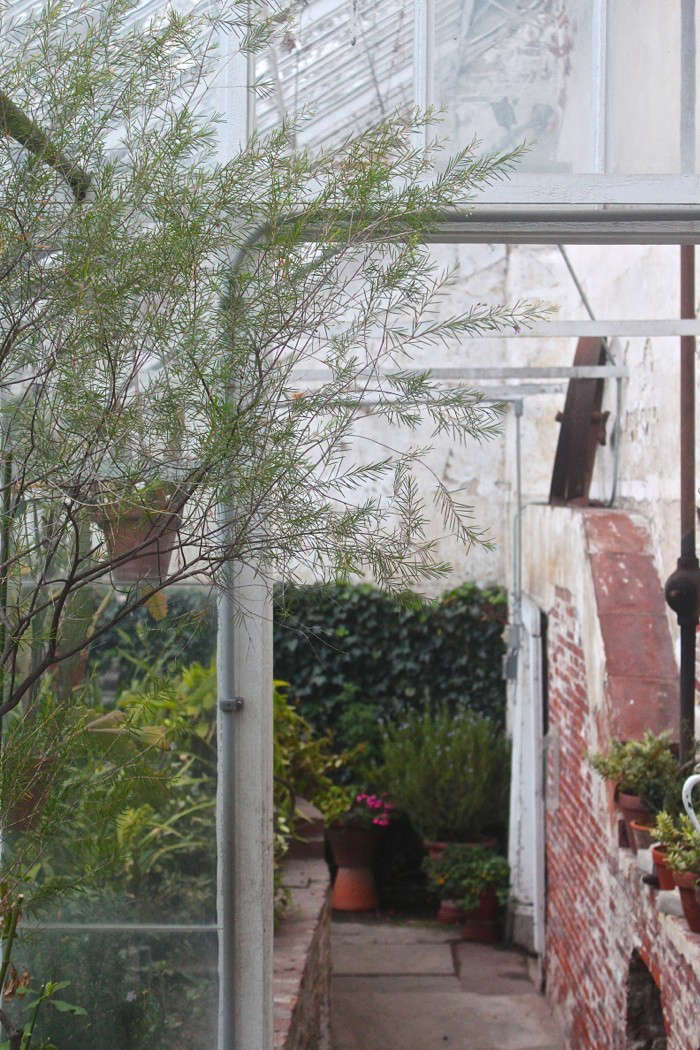Last weekend, while seeking a warm retreat from winter, the family and I chanced upon what turned out to be an historic and natural treasure in our own backyard. The Lyman Estate, located in Waltham, MA, just seven miles from our house, includes an elegant home and a sweeping landscape that would impress any Downton fan—and one of the most charming working greenhouses in the United States.
Among the oldest in America, the Lyman Estate Greenhouses were first built in 1798 as part of the summer estate of Boston shipping magnate Theodore Lyman. An avid horticulturalist, Lyman commissioned renowned 18th century gardener William Bell to design the grounds of “The Vale” in the English picturesque style, including wide open fields, copses of grand old trees (perfect for climbing), sparkling ponds, an undulating “peach wall,” kitchen and formal gardens, and rare lean to-style greenhouses. Today the historic greenhouses, which contain many centuries’-old plants from the original Lyman era, are preserved as a piece of living history by Historic New England.
Photography by Justine Hand.

Above: In what is now the citrus house, trellises along the glass ceiling host vibrant bougainvillea.

Above: Unlike the romanticized, filigreed conservatories of the later Victorian era, the Lyman greenhouses have a more earthy, utilitarian quality. In the grape house, support structures, pipes, and tanks necessary to maintain the optimal environment for the finicky vines are plainly visible.

Above: The greenhouses are around the back of a mansion built in 1793; landscape architect William Pell created a more intimate setting, enclosing the formal gardens with a 425-foot peach wall. Here against southern facing walls, the Lyman family grew espaliered peaches and pears well past a typical New England growing season.

Above: An avid horticulturalist, Lyman began construction of the first, lean-to style greenhouse along the peach wall in 1804. (An even earlier greenhouse was built in the woods behind in 1798.) Until the 1930s, Lyman, and later, his sons, continued to add structures along the wall to create a camellia, orchid, grape and finally, a nursery sales house, which today provides rare specimens for the visiting public.

Above: Built to provide the Lyman family with rare tropical flowers and fruits—”pineapple, citrus, figs and bananas—”during the winter months, the greenhouses are still bearing fruit, like this lemon, today.
Above: Lyman’s tradition of cultivating unusual blooms continues today with these Black Cat Petunia; (also available, three for $16.95, from Burpee).

Above: Built in 1820, the Camellia House today hosts one of the oldest collections in the US, with some specimens dating back more than 100 years.

Above: A delicate spray of Australian Tea Bush (Leptospermum), graces a seating area in the grape house.

Above: To provide ample room for the grapevines’ roots, 3.5-foot raised beds were created. Here, an old door leading under the beds is an example of the rich, rustic character of these greenhouses.

Above: Frolicking putti and a sunny oncidium cebolleta greet visitors to the orchid house.

Above: Still growing today are Black Hamburg grapes which Lyman acquired directly from the Royal greenhouses at Hampton Court in England. Also still here today are the original white grapes called Green Muscat of Alexandria.

Above: Canary Island Bellflowers (Canarina canariensis) climb the pipes in the grape house. Very much a working greenhouse, the specimens in bloom change each week, so there is always something new to see.

Above: Potted plants now rest on a ledge over one of the 13 original arches that led behind the peach wall, where heaters kept the tropical plants warm at night.

Above: Acid fronds of a feathery rabbit’s foot fern form a striking contrast against English Ivy.

Above: A masterpiece of landscape architecture, Pell’s design considered the relationship between the house and grounds from every angle, so that from every vantage point they appear seamlessly integrated.
The Lyman Estate Greenhouses are open to the public from 9:30 am – 4:00 pm, Wednesday – Sunday, December 15 – July 15 and Wednesday – Saturday, July 16 – December 14. They are closed on most major holidays. Admission is free; guided tours are available by appointment Monday – Friday for $6.00.
A map of the greenhouse location:
Looking for more groundbreaking American gardens? Go on An Upstate Adventure at Stonecrop Gardens.










Have a Question or Comment About This Post?
Join the conversation